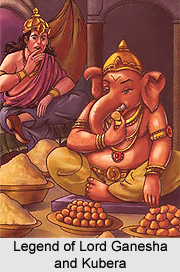 The Legend of Lord Ganesha and Kubera (Lord Kuber) establishes the belief that Vinayaka (Ganesha) is the destroyer of vanity, pride and selfishness. Lord Kubera, the god of wealth, was proud of his eternal riches and invited Lord Shiva and Goddess Parvati to an extravagant dinner. The celestial couple sent their son Ganesha to Alakaapuri, the capital city of Lord Kubera. Lord Ganesha requested Kubera to serve the food immediately, as he was very hungry. As the noble child started to eat, Kubera became filled with pride as he felt that he could feed several of young boys like Ganesha. As the child started to eat, there was no food left for anyone else. He requested Lord Kubera to serve more food, who became nervous and ordered his servants to cook more food. But Ganesha ate all the food and still remained hungry.
The Legend of Lord Ganesha and Kubera (Lord Kuber) establishes the belief that Vinayaka (Ganesha) is the destroyer of vanity, pride and selfishness. Lord Kubera, the god of wealth, was proud of his eternal riches and invited Lord Shiva and Goddess Parvati to an extravagant dinner. The celestial couple sent their son Ganesha to Alakaapuri, the capital city of Lord Kubera. Lord Ganesha requested Kubera to serve the food immediately, as he was very hungry. As the noble child started to eat, Kubera became filled with pride as he felt that he could feed several of young boys like Ganesha. As the child started to eat, there was no food left for anyone else. He requested Lord Kubera to serve more food, who became nervous and ordered his servants to cook more food. But Ganesha ate all the food and still remained hungry.
Lord Ganesha then ate all the fruits and vegetables that were served to him by the servants of Kubera. After the kitchen became empty, the divine child started to eat all the jewellery and furniture present in the palace of Kubera and in Alakaapuri. After Ganesha ate everything, he threatened to eat Kubera himself, as he was still hungry. Kubera, the god of wealth became worried and prayed to Lord Shiva to help him, as the insatiable appetite of the child was unlimited. Shiva, the father of Ganesha, gave his son a handful of roasted cereal grains. After the noble child ate the grains, his hunger was satisfied. Ganesha`s appetite was pacified after eating the grains presented with love and consumed with devotion.
Lord Kubera bowed to the child Ganesha in shame and asked for his forgiveness. The noble and kind Lord forgave the god of wealth and went Mount Kailash with Lord Shiva.
This article is a stub. You may enrich it by adding more information to it. You can send your write-up at content@indianetzone.com




















